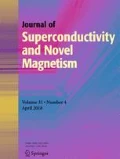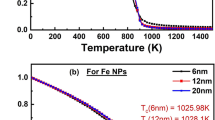Abstract
This paper is a contribution for the assessment and comparison of magnet properties based on magnetic field characteristics particularly concerning the magnetic induction uniformity in the air gaps. For this aim, a solver was developed and implemented to determine the magnetic field of a magnetic core to be used in Fast Field Cycling (FFC) Nuclear Magnetic Resonance (NMR) relaxometry. The electromagnetic field computation is based on a 2D finite-element method (FEM) using both the scalar and the vector potential formulation. Results for the magnetic field lines and the magnetic induction vector in the air gap are presented. The target magnetic induction is 0.2 T, which is a typical requirement of the FFC NMR technique, which can be achieved with a magnetic core based on permanent magnets or coils. In addition, this application requires high magnetic induction uniformity. To achieve this goal, a solution including superconducting pieces is analyzed. Results are compared with a different FEM program.




















Similar content being viewed by others
References
Noack, F.: NMR field-cycling spectroscopy: principles and applications. Prog. Nucl. Magn. Reson. Spectrosc. 18, 171–276 (1986)
Abragam, A.: The Principles of Nuclear Magnetism. Oxford University Press, London (1978)
Sousa, D.M.: Desenvolvimento de um espectrómetro de ressonância magnética nuclear de campo cíclico rápido. Ph.D. thesis, Instituto Superior Técnico, Lisbon (2003)
FEMM 3.3. www.femm.info/. Accessed 16 June 2011
Meissner, W., Oschsenfeld, R.: Ein neuer Effect bei Eintritt der Supraleitfahigkeit. Naturwissenschaften 21(44), 787–788 (1933)
Bean, C.P.: Magnetization of high-field superconductors. Rev. Mod. Phys. 36, 31–39 (1964)
Cermak, R., et al.: Overview of magnetic levitation principles and their application in Maglev trains. Adv. Eng. 2, 19–28 (2008)
Binns, K.J., Lawrenson, P.J., Trowbridge, C.W.: The Analytical and Numerical Solution of Electric and Magnetic Fields. Wiley, New York (1992)
Sardanha, A.U.: Aplicacion del método de elementos finitos al perfeccionamiento de pinzas amperimétricas. Thesis Doctoral, Departamento de Ingenharía Eléctrica, Universidade de Zaragoza (2007)
Bastos, J.P.A., Sadowski, N.: Electromagnetic Modeling by Finite Element Methods. Marcel Dekker, Inc., New York (2003)
Roque, A., Sousa, D.M., Margato, E., Maia, J., Marques, G.D.: Characterization of the fringing window of a magnetic core. In: IEEE EUROCON 2011—International Conference on Computer as a Tool, Lisbon, Portugal (2011)
Roque, A., Sousa, D.M., Margato, E., Maia, J., Marques, G.D.: Fringing window of a magnet with high flux density uniformity-magnetic core with and without superconductors. In: IEEE 2011 International Conference on Applied Superconductivity and Electromagnetic Devices (ASEMD2011), Sydney, Australia (2011)
Acknowledgements
The authors thank the “Center for Innovation in Electrical and Energy Engineering” (CIEEE) of the IST/TU Lisbon and the “Fundação para a Ciência e a Tecnologia” (FCT) for financial support of this work.
Author information
Authors and Affiliations
Corresponding author
Rights and permissions
About this article
Cite this article
Roque, A., Ramos, S., Barão, J. et al. Simulation of the Magnetic Induction Vector of a Magnetic Core to be Used in FFC NMR Relaxometry. J Supercond Nov Magn 26, 133–140 (2013). https://doi.org/10.1007/s10948-012-1709-8
Received:
Accepted:
Published:
Issue Date:
DOI: https://doi.org/10.1007/s10948-012-1709-8




